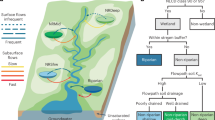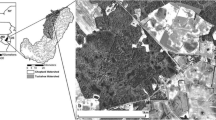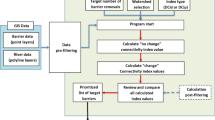Abstract
A hydrologic connectivity index (HCI) was developed to aid the US Clean Water Act Section 404 jurisdictional evaluation of headwater streams in montane watersheds, using the Cement Creek Watershed in the San Juan Mountains, Colorado as a case study. Jurisdictional determinations are required for many intermittent and ephemeral streams, where significant nexus with downstream traditional navigable waters (TNWs) must be evaluated. Three biophysical metrics (a streamflow metric, distance from the stream to the TNW, and slope between the stream and the TNW) for 239 streams in the watershed were used to develop three indices. These were then combined to develop the HCI, which is a compound, additive index. There was a large range of HCI values for ephemeral streams, which all require a significant nexus evaluation to determine jurisdiction. Statistical analysis of HCI values across stream duration and order classes showed that mean values differed significantly among classes. The flow index component constituted the greatest proportion of the HCI for perennial streams, was sensitive to the flow metrics used, and was greatest for high flows. Although ephemeral streams are only connected to the TNW less than 3 months of the year, the cumulative average annual flow contribution of ephemeral first-order streams can be 5 % of the total to the TNW, and their flow contribution is larger during high flows. Some ephemeral streams with high HCI values are farthest from the TNW but contribute the greatest flow out of all ephemeral reaches, and may have significant nexus with the river. The study shows that the HCI can be useful for initial evaluation of connectivity, significant nexus, and jurisdiction of headwaters at the watershed scale.













Similar content being viewed by others
References
Ali, G. A., & Roy, A. G. (2009). Revisiting hydrologic sampling strategies for an accurate assessment of hydrologic connectivity in humid temperate systems. Geography Compass, 3(1), 350–374.
Ali, G. A., & Roy, A. G. (2010). Shopping for hydrologically representative connectivity metrics in a humid temperate forested catchment. Water Resources Research, 46, W12544.
Ali, G. A., Roy, A. G., Turmel, M.-C., & Courchesne, F. (2010). Source-to-stream connectivity assessment through end member mixing analysis. Journal of Hydrology, 392, 119–135.
Bailey, R. G., Avers, P. E., King, T., & McNab, W. H. (eds.) (1994). Ecoregions and subregions of the United States (map) (supplementary table of map unit descriptions compiled and edited by McNab, W.H., and Bailey, R.G. Washington, D.C.: USFS, scale 1:7,500,000.
Bracken, L. J., & Croke, J. (2007). The concept of hydrological connectivity and its contribution to understanding runoff-dominated geomorphic systems. Hydrological Processes, 21, 1749–1763.
Bracken, L. J., Wainwright, J., Ali, G. A., Tetzlaff, D., Smith, M. W., Reaney, S. M., & Roy, A. G. (2013). Concepts of hydrological connectivity: research approaches, pathways and future agendas. Earth Science Reviews, 119, 17–34.
Buechler, D. (2010). Five Case Studies on the Effects of the SWANCC and Rapanos Supreme Court Rulings on Colorado Wetlands and Streams. Report Prepared for Ducks Unlimited, National Wildlife Federation and Trout Unlimited.
Capesius, J. P., & Stephens, V. C. (2009). Regional regression equations for estimation of natural streamflow statistics in Colorado: U.S. Geological Survey Scientific Investigations Report 2009–5136, 46 p.
Caruso, B. S. (2014). Analysis and classification of headwater streams in a mountain watershed for jurisdictional evaluation. Journal of the American Water Resources Association, 50(5), 1304–1324.
Caruso, B. S. (2011). Science and policy integration issues for stream and wetland jurisdictional determinations in a semi-arid region of the western U.S. Wetlands Ecology and Management, 19, 351–371.
Caruso, B. S., & Ward, R. C. (1998). Assessment of nonpoint source pollution from inactive mines using a watershed-based approach. Environmental Management, 22(2), 225–243.
Caruso, B. S., & Haynes, J. (2011). Biophysical-regulatory classification and profiling of streams across management units and ecoregions. Journal of the American Water Resources Association, 47(2), 386–407.
Caruso, B. S., & Haynes, J. (2010). Connectivity and jurisdictional issues for aquatic resources in the Rocky Mountains and Great Plains. Wetlands, 30, 865–877.
Chapman, S. S., Griffith, G. E., Omernik, J. M., Price, A. B., Freeouf, J., & Schrupp, D. L. (2006). Ecoregions of Colorado (color poster with map, descriptive text, summary tables, and photographs). Reston: U.S. Geological Survey. map scale 1:1,200,000.
COE and EPA (US Army Corps of Engineers and US Environmental Protection Agency) (2008). http://water.epa.gov/lawsregs/guidance/wetlands/upload/2008_12_3_wetlands_CWA_Jurisdiction_Following_Rapanos120208.pdf.
Cook, B. J., & Hauer, F. R. (2007). Effects of hydrologic connectivity on water chemistry, soils, and vegetation structure and function in an intermontane depressional wetland landscape. Wetlands, 27(3), 719–738.
Cote, D., Kehler, D. G., Bourne, C., & Wiersma, Y. F. (2009). A new measure of longitudinal connectivity for stream networks. Landscape Ecology, 24, 101–113.
Cowardin, L. M., Carter, V., Golet, F. C., & LaRoe, E. T. (1979). Classification of wetlands and deepwater habitats of the United States. U.S. Department of the Interior, Fish and Wildlife Service, Washington, D.C. Jamestown, ND: Northern Prairie Wildlife Research Center Online. http://www.npwrc.usgs.gov/resource/wetlands/classwet/index.htm (Version 04DEC1998).
Downing, D., Nadeau, T. L., & Kwok, R. (2007). Technical and scientific challenges in implementing Rapanos’ “Waters of the United States”. Natural Resources and Environment, 22(1), 45–63.
Earthjustice, Environment America, Clean Water Action, National Wildlife Federation, Natural Resources Defense Council, Sierra Club, & Southern Environmental Law Center (2009). Courting Disaster; How the Supreme Court Has Broken the Clean Water Act and Why Congress Must Fix It.
Freeman, M. C., Pringle, C. M., & Jackson, C. R. (2007). Hydrologic connectivity and the contribution of stream headwaters to ecological integrity at regional scales. Journal of the American Water Resources Association, 43(1), 118–133.
Fritz, K. M., Johnson, B. R., & Walters, D. M. (2006). Field operations manual for assessing the hydrologic permanence and ecological condition of headwater streams. EPA 600/R-06/126. Washington, DC: EPA Office of Research and Development.
Fritz, K. M., Johnson, B. R., & Walters, D. M. (2008). Physical indicators of hydrologic permanence in forested headwater streams. Journal of the North American Benthological Society, 27(3), 690–704.
Fritz, K. M., Hagenbuch, E., D'Amico, E., Reif, M., Wigington, P. J. Jr., Leibowitz, S. G., Comeleo, R. L., Ebersole, J. L., & Nadeau, T. L. (2013). Comparing the extent and permanence of headwater streams from two field surveys to values from hydrographic databases and maps. Journal of the American Water Resources Association, 49(4), 867–882.
Fullerton, A. H., Burnett, K. M., Steel, E. A., Flitcroft, R. L., Pess, G. R., Feist, B. E., Torgersen, C. E., Miller, D. J., & Sanderson, B. L. (2010). Hydrological connectivity for riverine fish: measurement challenges and research opportunities. Freshwater Biology, 55, 2215–2237.
Heathwaite, A. L., Quinn, P. F., & Hewett, C. J. M. (2005). Modelling and managing critical source areas of diffuse pollution from agricultural land using flow connectivity simulation. Journal of Hydrology, 304(1–4), 446–461.
Homer, C., Huang, C., Yang, L., Wylie, B. K., & Coan, M. J. (2004). Development of a 2001 National Land-Cover Database for the United States. USGS Staff -- Published Research. Paper 620.
Hwang, T., Band, L. E., Vose, J. M., & Tague, C. (2012). Ecosystem processes at the watershed scale: hydrologic vegetation gradient as an indicator for lateral hydrologic connectivity of headwater catchments. Water Resources Research, 48, W06514.
Jencso, K. G., & McGlynn, B. L. (2011). Hierarchical controls on runoff generation: topographically driven hydrologic connectivity, geology, and vegetation. Water Resources Research, 47, W11527.
Jencso, K. G., McGlynn, B. L., Gooseff, M. N., Wondzell, S. M., Bencala, K. E., & Marshall, L. A. (2009). Hydrologic connectivity between landscapes and streams: transferring reach- and plot-scale understanding to the catchment scale. Water Resources Research, 45, W04428.
Kundis Craig, R. (2007). Which way federalism under section 402? Natural Resources and Environment, 22, 20.
Lane, S. N., Reaney, S. M., & Heathwaite, A. L. (2009). Representation of landscape hydrological connectivity using a topographically driven surface flow index. Water Resources Research, 45, W08423.
Lang, M., McDonough, O., McCarty, G., Oesterling, R., & Wilen, B. (2012). Enhanced detection of wetland-stream connectivity using LiDAR. Wetlands, 32, 461–473.
Larsen, L. G., Choi, J., Nungesser, M. K., & Harvey, J. W. (2012). Directional connectivity in hydrology and ecology. Ecological Applications, 22(8), 2204–2220.
Leibowitz, S. G., & Nadeau, T. L. (2003). Isolated wetlands: state-of-the science and future directions. Wetlands, 23, 663–684.
Leibowitz, S. G., Wigington, P. J., Rains, M. C., & Downing, D. M. (2008). Non-navigable streams and adjacent wetlands: addressing science needs following the Supreme Court’s Rapanos decision. Frontiers in Ecology and the Environment, 6(7), 364–371.
Leopold, L. B. (1994). A view of the river. Cambridge: Harvard University Press.
Levick, L. J., Fonseca, D., Goodrich, D., Hernandez, M., Semmens, D., Stromberg, J., Leidy, R. A., Scianni, M., Guertin, D. P., Tluczek, M., & Kepner, W. (2008). The ecological and hydrological significance of ephemeral and intermittent streams in the arid and semi-arid American southwest. San Francisco: EPA, Region IX. Office of Water.
McGlynn, B. L., & McDonnell, J. J. (2003). Quantifying the relative contributions of riparian and hillslope zones to catchment runoff. Water Resources Research, 39(11), 1310.
McGuire, K. J., & McDonnell, J. J. (2010). Hydrological connectivity of hillslopes and streams: characteristic time scales and nonlinearities. Water Resources Research, 46, W10543.
Montgomery, D. R., & Buffington, J. M. (1997). Channel-reach morphology in mountain drainage basins. Bulletin of the Geological Society of America, 109, 596–611.
Murphy, J. (2007). Hard to navigate: Rapanos and the future of protecting our waters. Natural Resources and Environment, 22(1), 3–8.
Nadeau, T. L., & Rains, M. C. (2007). Hydrological connectivity between headwater streams and downstream waters: how science can inform policy. Journal of the American Water Resources Association, 43(1), 118–133.
Nadeau, T.L. (2011). Streamflow Duration Assessment Method for Oregon, U.S. Environmental Protection Agency, Region 10, Document No. EPA 910-R-11-002.
National Wildlife Federation, Ducks Unlimited, Trout Unlimited, and New Mexico Wildlife Federation (2008). Imperiled Treasures: How Recent Supreme Court Decisions and Agency Actions have Endangered Southwest Waters and Wildlife.
Omernik, J. M. (1987). Ecoregions of the conterminous United States (map supplement). Annals of the Association of American Geographers, 77(1), 118–125. map scale 1:7,500,000.
Pringle, C. M. (2001). Hydrologic connectivity and the management of biological reserves: a global perspective. Ecological Applications, 11, 981–998.
Reaney, S. M., Lane, S. N., & Heathwaite, A. L. (2009). Simulating the spatial distribution of hydrological connectivity under possible future climates—impacts on river flow dynamics and non-point source pollution. San Francisco: American Geophysical Union Fall Meeting. 14–18 December.
Reid, S. C., Lane, S. N., Montgomery, D. R., & Brookes, C. J. (2007). Does hydrological connectivity improve modelling of coarse sediment delivery in upland environments? Geomorphology, 90, 263–282.
Ries, K. G., Guthrie, J. D., Rea, A. H., Steeves, P. A., & Stewart, D. W. (2008). StreamStats: A Water Resources Web Application. USGS Fact Sheet 2008–3067, Baltimore, Maryland. 6 p.
Rocchio, J. (2006a). Rocky Mountain Alpine-Montane Wet Meadow Ecological System -Ecological Integrity Assessment. Colorado Natural Heritage Program, Colorado State University. Ft. Collins, Colorado.
Rocchio, J. (2006b). Rocky Mountain Subalpine-Montane Riparian Shrublands Ecological System Ecological Integrity Assessment. Colorado Natural Heritage Program, Colorado State University. Ft. Collins, Colorado.
Shore, M., Murphy, P. N. C., Jordan, P., Mellander, P.-E., Kelly-Quinn, M., Cushen, M., Mechan, S., Shine, O., & Melland, A. R. (2013). Evaluation of a surface hydrological connectivity index in agricultural catchments. Environmental Modelling & Software, 47, 7–15.
Simley, J. (2006) USGS National Hydrography Dataset Newsletter, Vol. 5, No. 4, February. http://nhd.usgs.gov/newsletters/News_Feb_06.pdf. Accessed 30 Mar 2013.
Sivapalan, M. (2005). Pattern, Process, and Functions: Elements of a Unified Theory of Hydrology a the Catchment Scale. In M. G. Anderson & J. J. Mc-Donnell (eds.), Encyclopedia of hydrological sciences (pp. 193–219). New York: John Wiley and Sons.
Stanton, M. R., Yager, D. B., Fey, D. L., & Wright, W. G. (2007). Formation and Geochemical Significance of Iron Bog Deposits, Chapter E14. In S. E. Church, P. von Guerard, & S. E. Finger (eds.), Integrated investigations of environmental effects of historical mining in the Animas River Watershed, San Juan County, Colorado. USGS Prof Paper 1651, Washington DC, pp 689–720.
Stieglitz, M., Shaman, J., McNamara, J., Engel, V., Shanley, J., & Kling, G. W. (2003). An approach to understanding hydrologic connectivity on the hillslope and the implications for nutrient transport. Global Biogeochemical Cycles, 17(4), 1105.
Strahler, A. N. (1957). Quantitative analysis of watershed geomorphology. American Geophysical Union Transactions, 38, 913–920.
Tetzlaff, D., Soulsby, C., Bacon, P. J., Youngson, A. F., Gibbins, C., & Malcolm, I. A. (2007). Connectivity between landscapes and riverscapes—a unifying theme in integrating hydrology and ecology in catchment science? Hydrological Processes, 21, 1385–1389.
Tetzlaff, D., Soulsby, C., & Birkel, C. (2010). Hydrological connectivity and microbiological fluxes in montane catchments: the role of seasonality and climatic variability. Hydrological Processes, 24, 1231–1235.
USGS (U.S. Geological Survey) (1999) National Elevation Dataset Fact Sheet 148–99. http://egsc.usgs.gov/isb/pubs/factsheets/fs14899.html#information. Accessed May 22 2013.
USGS (2006) National Elevation Dataset. http://ned.usgs.gov/. Accessed May 22 2013.
USGS (2013a) The StreamStats Program. http://streamstats.usgs.gov/ssdis.html. Accessed March 30 2013.
USGS (2013b) National Gap Analysis Program (GAP) Land Cover Data Portal. http://gapanalysis.usgs.gov/gaplandcover/. Accessed May 22 2013.
Vance, L. K. (2009). Geographically isolated wetlands and intermittent/ephemeral streams in Montana: extent, distribution, and function. Montana Natural Heritage Program, Prepared for Montana Department of Environmental Quality and US Environmental Protection Agency.
Vance, L. K. (2010). Post SWANCC and Rapanos jurisdictional determinations in Montana: four case studies of waters at risk. Montana Natural Heritage Program, Prepared for National Wildlife Federation, Ducks Unlimited and Trout Unlimited.
Walton-Day, K., Runkel, R. L., & Kimball, B. A. (2012). Using spatially detailed water-quality data and solute-transport modeling to support Total Maximum Daily Load development. Journal of the American Water Resources Association, 48, 949–969.
Acknowledgments
Thanks to the University of Canterbury for providing time and funding to undertake this study as part of my sabbatical in Colorado. Thanks also go to Crile Doscher and James Robb for initial GIS discussions and support, and to several anonymous reviewers for helping to improve the paper.
Author information
Authors and Affiliations
Corresponding author
Rights and permissions
About this article
Cite this article
Caruso, B.S. A hydrologic connectivity index for jurisdictional analysis of headwater streams in a montane watershed. Environ Monit Assess 187, 635 (2015). https://doi.org/10.1007/s10661-015-4862-2
Received:
Accepted:
Published:
DOI: https://doi.org/10.1007/s10661-015-4862-2




